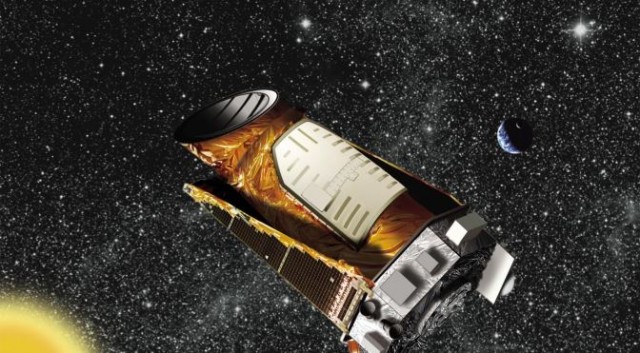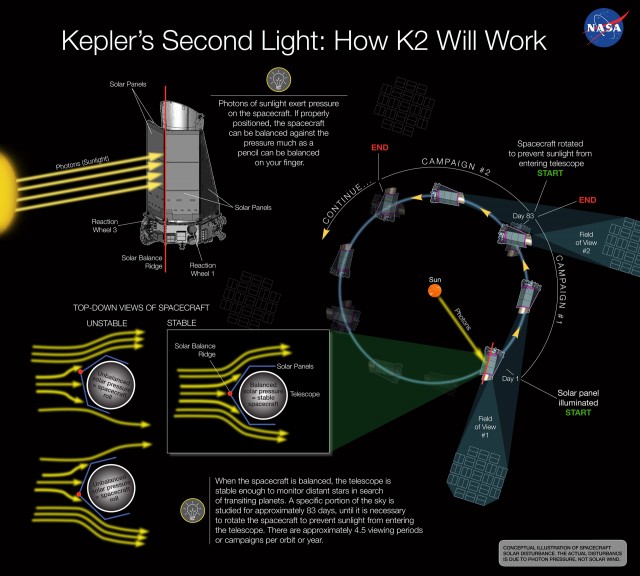It looks like you're using an Ad Blocker.
Please white-list or disable AboveTopSecret.com in your ad-blocking tool.
Thank you.
Some features of ATS will be disabled while you continue to use an ad-blocker.
5
share:
Over the past year, we’ve told the sad story of NASA’s Kepler space observatory, and how the failure of two vital components have resulted in the sad and premature retirement of humanity’s best tool for spotting Earth-like planets elsewhere in the universe. Just when all hope seemed lost, though, NASA has approved an ingenious plan to bring Kepler back online — a novel, never-before-seen technique that uses the Sun’s constant bombarding of photons upon Kepler’s solar panels to keep the telescope pointed in the right direction.
NASA resurrects planet-hunting Kepler


This is excellent news for Kepler, hopefully she will be able to continue her mission for a few more months, maybe longer. I also find the method employed to correct the problem fascinating!
edit on 28-11-2013 by andy06shake because: (no reason given)
reply to post by andy06shake
From the Source, which tells us how they will jerryrig the vessel to sail different seas:
From the Source, which tells us how they will jerryrig the vessel to sail different seas:
This method isn’t without it flaws, though. As Kepler orbits around the Sun, the angle of the sunlight changes, until eventually it hits the side of the spacecraft that isn’t covered in solar panels. To compensate, Bell Aerospace proposes that Kepler’s orbit around the Sun be broken into individual “campaigns,” where it focuses on a single patch of sky for 83 days — and then, after it travels far enough around the Sun, it turns around and looks at another patch of sky. One orbit would be broken into four campaigns of 83 days, with each campaign analyzing a different patch of sky. After a few orbits of the Sun, the Kepler K2 plan would produce enough scientific data to locate some more exoplanets.
reply to post by Aleister
Excellent news!
I hoped they would be able to salvage the telescope somehow.
I really hope this works and Kepler continues to find exoplanets for a long time to come.
Excellent news!
I hoped they would be able to salvage the telescope somehow.
I really hope this works and Kepler continues to find exoplanets for a long time to come.
Is this the one who kept re-booting and was "dead" according to NASA?
reply to post by yeahsurexxx
Kepler relies on precision hardware called reaction wheels to keep itself pointed in a single direction. It launched with four and it needs three to aim properly. One of the reaction wheels failed in 2012, and a second showed signs of failure that led it being put it into a fuel-saving mode. So let's hope this new idea/fix at least returns some functionality even if it is limited.
Kepler relies on precision hardware called reaction wheels to keep itself pointed in a single direction. It launched with four and it needs three to aim properly. One of the reaction wheels failed in 2012, and a second showed signs of failure that led it being put it into a fuel-saving mode. So let's hope this new idea/fix at least returns some functionality even if it is limited.
That's the one thing about space exploration that's so interesting to me: the need for precision computation and principles to produce the desired
result. This is the kind of thing which demonstrates precision can do a lot of work, if used in the proper circumstances. There're a variety of cases
in technology where if something is off by just a fractional margin, the whole thing explodes in your face. Attaining this margin of error is
difficult because so many things can go wrong at different stages.
It's like writing a piece of code for a nuclear reactor control panel. It's like being expected to create a fail-safe system or to install multiple redundancies.
I wonder if they had this has a backup plan or if it just was an "ah ha!" moment? I personally think this idea has probably been on a couple minds over the years. To go from an idea to an application is a big leap, though, since bugs so easily crop up.
It's like writing a piece of code for a nuclear reactor control panel. It's like being expected to create a fail-safe system or to install multiple redundancies.
I wonder if they had this has a backup plan or if it just was an "ah ha!" moment? I personally think this idea has probably been on a couple minds over the years. To go from an idea to an application is a big leap, though, since bugs so easily crop up.
edit on 28-11-2013 by jonnywhite
because: (no reason given)
new topics
-
In four years, you don’t have to vote again.
2024 Elections: 1 hours ago -
Prize or Zonk
General Chit Chat: 3 hours ago -
I've realized something about Politics recently.
US Political Madness: 4 hours ago -
France bans head coverings but allows Christianity to be mocked at Olympics.
Political Conspiracies: 6 hours ago -
Woo time it aint over yet
Paranormal Studies: 8 hours ago -
BIDEN-HARRIS Preparing to Also Make Us Pay For Illegal-Aliens to Attend College Prep Programs.
Political Ideology: 11 hours ago
top topics
-
The Main Question and A Bonus Question
General Conspiracies: 13 hours ago, 13 flags -
Is Kamala Good for America ?
Political Issues: 13 hours ago, 12 flags -
BIDEN-HARRIS Preparing to Also Make Us Pay For Illegal-Aliens to Attend College Prep Programs.
Political Ideology: 11 hours ago, 9 flags -
Did Russia just attack a NATO nation?
The Gray Area: 16 hours ago, 6 flags -
The Most Crime Ridden Games Ever
World Sports: 13 hours ago, 6 flags -
In four years, you don’t have to vote again.
2024 Elections: 1 hours ago, 4 flags -
A Preliminary Question
General Conspiracies: 14 hours ago, 3 flags -
Olympics France 2024 Opening Ceremony
World Sports: 14 hours ago, 3 flags -
Woo time it aint over yet
Paranormal Studies: 8 hours ago, 3 flags -
France bans head coverings but allows Christianity to be mocked at Olympics.
Political Conspiracies: 6 hours ago, 2 flags
active topics
-
Shots Fired At Trump Rally Trump Looks Wounded
US Political Madness • 1849 • : daskakik -
In four years, you don’t have to vote again.
2024 Elections • 6 • : Threadbarer -
The Most Crime Ridden Games Ever
World Sports • 6 • : SecretKnowledge2 -
Olympics France 2024 Opening Ceremony
World Sports • 11 • : putnam6 -
France bans head coverings but allows Christianity to be mocked at Olympics.
Political Conspiracies • 22 • : BedevereTheWise -
I've realized something about Politics recently.
US Political Madness • 7 • : wAnchorofCarp -
Prediction watch how fast the war in Ukraine ends.
Dreams & Predictions • 65 • : annonentity -
Lue Elizondo Announces New UFO Book "IMMINENT" Coming August 2024
Aliens and UFOs • 53 • : baablacksheep1 -
Is Kamala Good for America ?
Political Issues • 193 • : covent -
The World Is Not Being Run By Human Beings
Aliens and UFOs • 33 • : andy06shake
5
